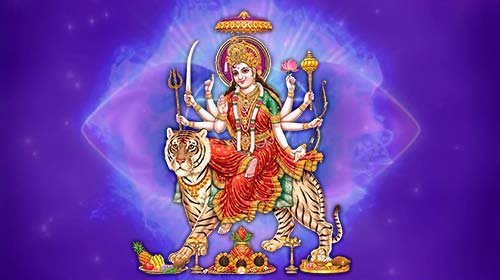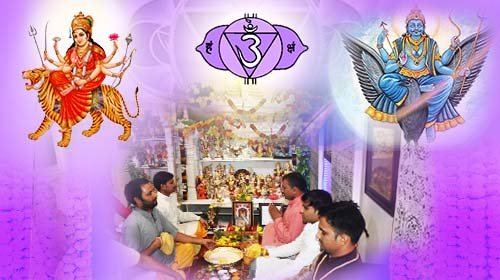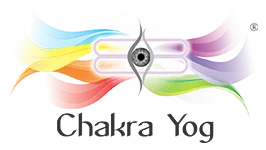Deities connected to Ajna Chakra

The Chakra system symbolizes the vital energy of the physical body, emotions, intellect, and spirit. Positive attributes associated with the Chakras, such as love, intuition, and bravery, are also associated with Hindu deities. By studying about the many deities connected with the Chakras (swirling energy vortexes) you may learn how to foster and sharp their beneficial qualities in your life, bringing you one step closer to the divine.
These spinning energy centers have been compared to the pole that must be climbed. It’s a slippery pole. As a result, the gods’ assisting hand and their resonating energies with these chakras aid in the ascension of the devotee. Since ancient periods in human history, total submission to the Gods has been raising their connected chakras.
Lotus flowers represent these chakras with different pretty patterns. This flower thrives in lakes and pools, taking root under the surface in the slimy muck where no light can enter. Its stem shoots upward toward the light, breaking the surface into fresh air and sunlight. The sun’s energy then nourishes the bud and leaves until the beautiful lotus flower blooms. Ajna is the name given to the sixth chakra. Awareness grows from the lower chakras as ascending kundalini energy and travels through the waters of the intellect, becoming more refined as it evolves, until it finally bursts into the light of the superconscious mind, where it spiritually blossoms into the 1,008-petaled lotus chakra at the top of the head.
The lotus flower begins in the dirt, flows through the water, and ultimately blooms on the surface. There are many unique phases that it goes through while in the mud: The dirt symbolizes the instinctual mind, the water represents the intellectual mind, and the surface represents the superconscious mind, which blossoms to become one with God.
Therefore, connecting with the deity associated with each chakra makes to open and balance this chakra as per bhakti or resonance between both energies. The more the connection is established the deeper the healing of the corresponding energy center. This happens because these energies entwined in each chakra are the same energies brought by each deity connected to them. The resonating deity of Ajna chakra is goddess Durga. By sharping our connection with her and her forms (navadurgas) our whirling energy vortexes known as our chakras leads us to a spiraling union not only with these deities but ultimately also with the supreme and only one Brahman which represents all forms of god.

To contact your Chakra god, focus on the deity’s picture and attempt to see it in your thoughts. This is best accomplished by gradually building up the picture, and adding details as you focus on it. Here is a simple meditation to assist you in developing a connection with your god or goddess:
- To begin, imagine the deity or goddess as a dignified sitting figure.
- Examine the number of arms and faces that they have attributed.
- Begin to visualize the skin color and jewelry and other details appearing on the god’s portrayal gradually.
- Consider the garments that the god is wearing.
- See whether they have any type of things in their hands since they generally imply god attributes to meditate upon too.
- Allow your thoughts to concentrate on it and observe what comes to you.
Each Chakra is filled with the male god’s vitality as well as the energy of their female pair or consort, a power known as Shakti.

Durga is the Supreme Lord’s Active Energy. She represents purity, wisdom, truth, and self-realization. She is also known as Shakti or Devi as a warrior goddess. The term ‘Durg’ in Sanskrit signifies a Fort, or a secure fortified location. In addition, ‘Durga’ denotes “invincible.” ‘Dur’ also means ‘jail,’ while ‘Ga’ means ‘to go or approach.’ It refers to the person who sends or forces miscreants to jail. She is the Active Principle in the affairs of the Universe. She punishes the obnoxious parts. She is in control of this material world, which is referred to as ‘Dukhalaya,’ or the place full of sufferings (‘Dukha’ means pains and ‘Alaya’ means place, as in ‘Vachnalaya,’ which is a library, and ‘Bhojnalaya,’ which is a location where food is provided). She is one of the five principal forms of Goddess Bhuvaneshvari, according to the Devi-Bhagavata Purana. Her tale revolves on the battle against evils and demonic powers that threaten peace, prosperity, and Dharma, or the power of good over evil. Durga is said to unleash her divine wrath on the wicked in order to liberate the downtrodden, and this includes destruction in order to empower creation.
Religion and art historians generally link the first depictions of Durga to the seals of the Indus Valley Civilization. There are various clues to her in the early Vedic literature, and she appears as an autonomous divinity by the time of the epics. Durga is regarded as a motherly deity, and is often shown as a beautiful lady riding a lion or tiger, with many arms, each bearing a weapon, and frequently fighting demons. She is revered by members of the goddess-centric cult Shaktism and is significant in other religions like as Shaivism and Vaishnavism. Durga is connected and affiliated with various deities in different cultures. Many Goddess Durga followers chant Saptashloki Durga Saptashati to seek her blessings.
She is a multidimensional goddess with many divine aspects, titles, and avatars. Shakti, or Mahishasuramardini, is the remover of evil with ten strong arms, each bearing its unique weapon. Durga is also Sati, the object of death who surrenders Her realm, and Kali, who is dark as the night in Her anger and fury and wears a garland of skulls around Her neck. She is the peaceful Parvati, Lord Shiva’s spouse, as well as Bhavani, the emblem of life. Amba, Basanti, Annapurna, Tara, Ambika, and Jagadhatri are some of her other names. Durga is recognized as the most powerful of the Goddesses in India. She appears as Santoshi Mata, standing with Her tiger. However, in Her serene incarnation, She is also worshiped as Shanta Durga. In all of her incarnations, embodies the concept of redemption and sacrifice. She is the epicenter of celestial wisdom, riches, power, richness, and beauty, and Her daughters are Saraswati and Lakshmi. Goddess Durga is the divine life-force and intrinsic dynamic energy through which the highest awareness reveals itself.

Goddess Katyayani is one of Goddess Durga’s nine manifestations. Katyayani is a powerful embodiment of Shakti, the holy feminine force. Durga means “the indomitable,” and Katyayani, the warrior Goddess, is one among them. On the sixth day of the Navratri celebration, she is worshiped as the sixth of Durga’s nine avatars. She is a highly respected avatar of Goddess Durga who is reputed to eliminate evil. She has four hands and carries a long sword in one and a lotus in the other two, according to the iconography. Her fourth hand is in Abhaya mudra, and she blesses Her followers with it. Her devotees are freed from the shackles of ego and rigidity in life while their sins are dissolved.
According to ancient texts, years ago, there lived a sage known as ‘Kat,’ who named his offspring ‘Katya’. After a while, Katya’s descendant was born, who became known as the sage ‘Katyayan.’ Sage Katyayan had no children. He did a lot of penance and worshiped and prayed to the gods to have a child. During that time, the evil spirit Mahishasura was causing a lot of trouble and causing a lot of problems for the gods. His persecution grew steadily worse. The divine beings moved toward Vishnu in search of a way to end Mahishasura. Shiva and Brahma followed Vishnu’s command, and the Trinity (as Vishnu, Shiva, and Brahma) then transmitted flames. These flares took the form of Goddess Katyayani. Goddess Katyayani was given the name ‘Katyayani’ because she was born as the child of Sage Katyayan. Goddess Katyayani was conceived as a warrior to slay evil spirits. She had a gleaming structure, three eyes, eighteen hands, and was as radiant as a thousand suns. All the gods bestowed weapons on goddess Katyayani in order for her to defeat the demon Mahishasura. Shiva gave Her a trident, Vishnu a disk (Sudarshana Chakra), Varuna a conch shell (shankha), Agni a dart, Vayu a bow, Surya a quiver, Indra a jolt, Kubera a mace, Brahma a rosary and a water pot, Kala a sword and a shield, and Vishwakarma a fight hatch Katyayani mounts a lion. Ma Katyayani continued her journey towards the Vindhya Mountains, where Mahishasura lived, armed with all of her equipment. She eventually killed the demon with the trident of Lord Shiva.

As we have seen there are several deities connected with our Ajna chakra in very deep association and resonance with the qualities of our Third Eye chakra. Total surrender to these deities is one of the ways to assist us in enhancing the function of our Ajna (Third Eye) Chakra, which enables us to see clearer beneath the surface and perceive the whole picture of life in its full dimension. The qualities and attributes of the above deities are the same as the ones of our Ajna chakra, always resonating at the same vibrational frequency.
Healing our Third Eye chakra with the helping hands of the gods may actually be done in plentiful ways. Starting from meditation to contemplation of the deity’s pictures, through their mantras, yantras and wearing Rudraksha beads ruled by them are all proven effective ways to balance Ajna so that it works productively for you.






